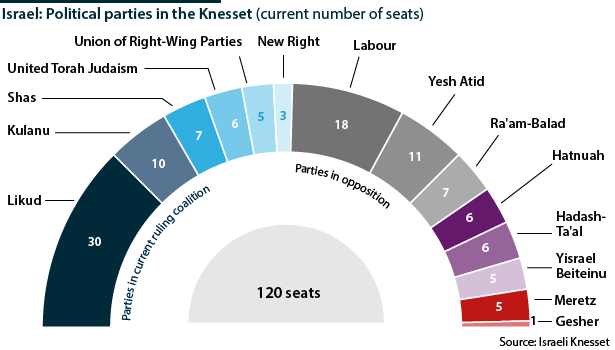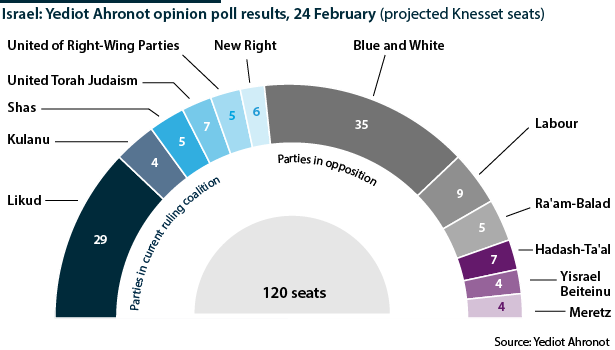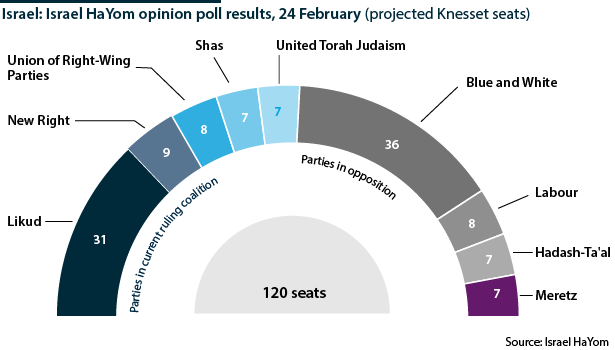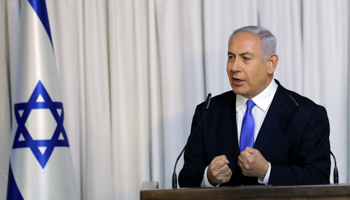The electoral threshold may swing Israeli vote outcome
For the first time in ten years, Netanyahu has a credible challenger as he also faces the prospect of corruption charges
Prime Minister Binyamin Netanyahu is cutting short his visit to Moscow today as pressure mounts ahead of the April 9 election, especially given the possibility of corruption charges against him. For the first time since 2009, Netanyahu is facing a formidable challenge from a new centrist party, Blue and White, established by Benny Gantz, a former military chief of staff, and former finance minister Yair Lapid. The election can be broadly characterised as a battle between two main blocs -- the religious right and the centre-left.
What next
The close race expected between Netanyahu and Gantz may lead to the disappearance of smaller parties. Recent polls show that several parties are barely crossing the necessary 3.25% threshold to enter the Knesset. The disappearance of one party, from either side, could potentially be a game-changer.
Subsidiary Impacts
- Blue and White will need to articulate specific policies to maintain its positive momentum.
- A merger of far-right groupings may shift voters towards the New Right party.
- The corruption allegations against Netanyahu could prove disruptive to voting intentions.
Analysis
Final electoral lists were submitted by parties on February 21 ahead of election day on April 9. The landscape only really became clear late in the game, with several significant mergers agreed just hours before the deadline.
Alliance building
Benny Gantz's new Hosen LeYisrael party reached a deal with Lapid's Yesh Atid, another centrist party, late the night before the deadline to form the Blue and White alliance. The two have agreed to a power-sharing deal in which Gantz would be prime minister for the first two and a half years of the five-year parliament, after which Lapid would take over.
They have been joined by two other former commanders of the Israel Defence Force, Gabi Ashkenazi (the 'matchmaker' between Gantz and Lapid) and Moshe Yaalon.
On the right, Netanyahu pushed the pro-settler Jewish Home, already in partnership with the far-right Tkuma, into a merger with Otzma Yehudit -- an even more extreme party (see ISRAEL: Premier panders to the far right ahead of poll - February 21, 2019). The new bloc is called the Union of Right-Wing Parties (URWP).
In exchange for agreeing to the merger, Netanyahu offered the URWP two cabinet portfolios in any future government, and a place on Likud's own party list.
A much-debated merger on the left between the Labour party led by Avi Gabbay and Meretz did not materialise after Gabbay decided against it, despite strong public appeals.
Meanwhile, the Joint List, a coalition of four Arab-led parties, splintered into two groupings, with Ra'am and Balad forming a partnership on one side, and Ta'al teaming up with Hadash on the other.
Two blocs
The vote has often been characterised as a personal contest between Netanyahu and Gantz. Yet beyond the so-called 'Battle of the Benjamins', this is a race between two main blocs: the religious right, comprising most parties in the current Likud-led coalition, and the centre-left, featuring Blue and White and the parties in the parliamentary opposition (see ISRAEL: Religious right will hold coalition hostage - March 14, 2018).
An exception is Yisrael Beiteinu, a right-wing party that recently quit the government, but whose leader, former defence minister Avigdor Lieberman, has indicated that he would join a new Netanyahu-led cabinet.
Although voters may move between parties within each bloc, it is rare for them to switch from one bloc to another. Opinion polls show both blocs as evenly matched, commanding roughly 60 of the 120 Knesset seats each.
Threshold challenge
As the blocs take centre stage, voters may opt to vote only for the bigger parties identified as the main representatives of these broad groupings: Likud, and Blue and White. That increases the probability that smaller parties will not cross the 3.25% vote threshold to enter the Knesset.
Indeed, the outcome of the election may be determined by parties' abilities to achieve the votes required to obtain seats at all. This dynamic is illustrated by two opinion polls published by newspapers Yediot Ahronot and Israel HaYom on the same day, February 24.
Yediot Ahronot sees the parties of the current coalition failing to achieve a majority and several smaller parties passing the Knesset's entry threshold.
The latter, meanwhile, produces a scenario in which, although the share of votes cast is not substantially different, several parties fail to pass the threshold. This poll predicts an expanded majority for the ruling coalition, from 61 to 62 seats.
Parties such as Meretz or Yisrael Beiteinu are in real danger of not crossing the line, potentially leading to a loss for their bloc.
It is this threat that prompted Netanyahu to broker the URWP merger, despite its inclusion of elements considered too extreme by many. Indeed, Netanyahu and Jewish Home even stated that it is a 'technical bloc' that will be disassembled once members enter the Knesset.
This dynamic also means that Gabbay risks a backlash on the left if his refusal to align with Meretz leads to the latter's disappearance.
Right-wing balance
The creation of the URWP may have ramifications for the balance of power inside the religious right bloc, as many traditional supporters of the Jewish Home resent the inclusion of Otzma Yehudit.
Some Jewish Home voters may shift support to the New Right
They may instead back the New Right party, headed by ministers Naftali Bennett and Ayelet Shaked, both of whom left Jewish Home to form the New Right with the aim of opening up their party to secular Jews.
Corruption charges
Aside from the Knesset arithmetic, Netanyahu's next consideration is the attorney general's expected announcement in the coming days on whether to charge him with corruption (see ISRAEL: Corruption scandal could force early elections - March 10, 2017). Netanyahu will likely be indicted, although hearings will come after the vote.
The prime minister's hope is that, after winning the elections, he will be able to pass a bill in the Knesset that would provide him with immunity from prosecution during his term in office.
Most of his current partners in government are likely to support this, with only Finance Minister Moshe Kahlon's Kulanu party openly declaring opposition to it.
Breaking the mould?
Gantz and Lapid have stated their intention to break the pattern of voting by bloc and their campaign is attempting to appeal to right-wing voters tired of Netanyahu.
Blue and White has been intentionally evasive over its programme
Blue and White will now be put to the test as it attempts to articulate specific policies. At their party's launch event, Gantz and Lapid focused on a positive agenda of unity and reconciliation, urging an end to Netanyahu's decade-long rule. In presenting their party as open to all, they were intentionally vague over their agenda.
As the campaign moves closer to the day of the vote, and to consolidate the enthusiasm they have generated, Gantz and Lapid will need to be more specific on key issues, such as the Israeli-Palestinian conflict, security and the economy, without dropping supporters. They will also have to formulate their approach vis-a-vis Israel's Arab citizens.
In this context, Likud will conduct a negative smear campaign against Blue and White, depicting members as 'leftists in disguise', and questioning the legitimacy of potential reliance on Arab parties after the elections to form an 'obstructive bloc' to prevent Netanyahu returning to office.
If Gantz is tasked with forming the next government, it is improbable that he would form a coalition with the Arab-led parties. He may court the ultra-Orthodox Shas and United Torah Judaism parties, although it is questionable whether either would be willing to work with the centre-left.



